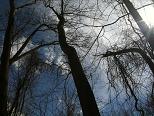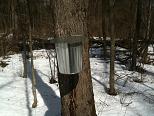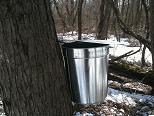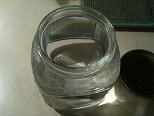Sugar Maples are large trees growing 70 to 100 feet tall. The leaves are opposite, 3-1/2 to 5-1/2 inches wide with 5 palmately divided lobes. The lobes have 5 main veins from the base and have few narrow, long-pointed teeth. Leaves are dull dark green above and paler green beneath. The leaves turn red, yellow and orange in the Fall. The bark is gray-brown with rough vertical grooves and loose-edged plates.
The season to collect Maple Sap is from early March to approximately mid April. Ideally, the temperatures get below freezing at night and then rise to above freezing temperature during the day. The sap will flow as the temperatures rise above freezing.
I took two collecting buckets and drilled holes in two trees at a slight angle so that the sap could drip out. I then tapped the spile into the tree and hung the bucket on the hook that came with the spile. The cover is to keep the rain out that could dilute the Maple Sap. Putting the cover on is a little bit more tricky than I thought. I still haven't figured out the easiest way to do it.
I collected 1/2 gallen of Maple Sap from approximately 12 noon to 8:30am the next day. That is pretty good for just two 12-inch diameter trees! I filtered the Maple Sap and then tasted it. It is very tasty and refreshing with a suble sweetness.





